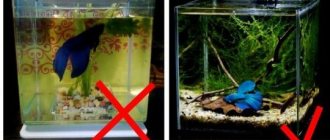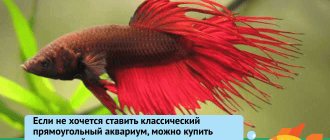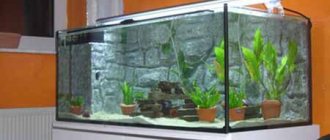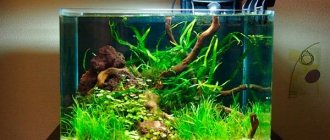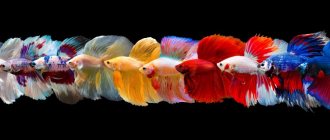Profile containers for cockerel
Bettas are distributed throughout the world and are one of the most popular aquarium fish. To save aquarists from choosing the right aquarium, manufacturers have created specialized profile tanks designed specifically for bettas.
When creating profile aquariums, the following points were taken into account:
- behavioral characteristics;
- coloring;
- activity.
Profile tanks are rectangular-shaped aquariums in which the length and height are approximately equal. They have a backlight located in the upper part of the container - it emphasizes the beauty and brightness of the colors.
In the center of a profile aquarium there is usually a large driftwood or a mound of stones. Minimum volume - 20 l. Among the profile aquariums, there are models with partitions that divide the tank into sections.
Equipment
Bettas do not require specialized equipment. It is necessary to prepare a siphon for the cockerel to remove food debris and dirt from the substrate. Due to their tropical origin, fish are sensitive to temperature changes, so if you cannot establish a constant comfortable temperature in the room with the tank, then buy a heater. An aeration device (compressor) is not installed; they manage well without additional oxygen in the water.
You will also need a water thermometer to know whether the temperature of the aquarium is decreasing or increasing. Any kind of lighting, it is usually oriented towards the requirements of vegetation, not pets; fish feel good in an aquarium with lighting.
A lid is required; between it and the walls of the aquarium there should be a small gap for air exchange.
Features of choosing an aquarium for a betta
When choosing a “home” for bettas, it is important to assess the needs of these fish. Many inexperienced aquarists are mistaken in thinking that a small container of water is enough for bettas, in which they are usually kept in pet stores.
In fact, betta fish need space to move and clean water - these are the main conditions for their successful maintenance. But it wouldn’t hurt to have a miniature aquarium - for spawning, raising fry or transplanting sick fish.
What to consider when choosing an aquarium:
- how many fish will it contain;
- what equipment is to be installed in it, and what equipment can be discarded.
Container size
The length of adult bettas reaches 6 cm. Mobile fish need space to move. If you place them in a cramped container, they will move little, mope, and eventually get sick.
Why mini-aquariums are not suitable for bettas:
- there is no room for plants;
- difficult to maintain a stable temperature;
- there is no possibility to install a filter and decorations;
- difficult to care for - the aquarium needs to be cleaned, washed, changed water once a week, and this causes stress in the fish.
In their natural habitat, bettas feel great even in muddy water - thanks to biochemical processes, it is cleared of poisonous and toxic substances. This effect cannot be achieved in small vessels.
In a small aquarium, waste products quickly accumulate. By poisoning the water, they cause intoxication and illness in cockerels. To prevent this from happening, it is necessary to comply with the norm - 15-20 liters per rooster. This is enough for both fish and plants with grottoes.
Aquarium shape
The main condition regarding the choice of aquarium shape is the exclusion of round containers. Many people think such tanks are beautiful, but they are not at all suitable for bettas.
Why is a round aquarium bad?
- harms the health of fish due to lack of space;
- the rounded shape distorts the surrounding world in the eyes of the fish, which is why its vision and psyche are impaired, and a feeling of constant discomfort appears;
- inconvenient to care for - difficult to remove algae from glass;
- it is impossible to create a beautiful background.
Betta fish experience similar inconveniences in glass-shaped aquariums.
It is recommended to give preference to aquariums:
- classic rectangular;
- square;
- panoramas;
- multifaceted (with smooth, non-convex walls).
Glass or plastic
Bettas do quite well in aquariums made of any transparent material - glass and plastic. When deciding which aquarium is best to buy, take into account the characteristics of the materials used.
Aquariums are:
- From glass. Such tanks are classics. They are cheaper than their plastic counterparts. They are easier to care for. Glass walls are more transparent and look more impressive than plastic ones.
- Made of plastic. It is lighter than glass. It does not break, so it is recommended for homes with children and pets. Even if the aquarium falls or is hit, it will not break. Plastic containers may only be cleaned with soft sponges. If you rub the plastic walls with a metal scraper, they will leave scratches.
There are no special differences regarding the installation and launch of plastic and glass aquariums. In both cases, a standard procedure is carried out - before the fish are introduced, the water with the plants settles and a turbidity phase passes.
Plants
Before planting plants in the aquarium, fine gravel is poured onto its bottom. If you are going to plant plants, the recommended layer thickness is 5 cm; if the algae is artificial, 2 cm is enough.
Almost any plants are suitable for planting - cockerels are not inclined to harm their growth. It is recommended to plant algae along the back wall and on the sides.
How to prepare aquatic plants for planting:
- Before planting, immerse them in a slightly pink solution of potassium permanganate for 2 minutes.
- If the plants have too long roots, trim them.
- Remove excess shoots.
Plants not only decorate the aquarium, but also, together with driftwood, create a habitat similar to the natural one. Plants are natural filters that purify water from fish waste.
How to plant plants in an aquarium:
- Place a layer of substrate on the bottom. The minimum thickness is 4-5 cm.
- Pour some water into the aquarium - enough to lightly cover the soil.
- Make small depressions in the thickness of gravel, sand or substrate.
- Place special nutritional tablets for plants in the holes made - they are sold in pet stores.
- Plant your plants. If they have massive roots, use your hands; if the plants are groundcovers, use tweezers.
Tall types of plants are planted near the back wall - to create a background, lower ones - in front and on the sides.
Equipment
Bettas do not require any special equipment. These fish are hardy and unpretentious, so to set up an aquarium, a siphon will be enough to remove food residues and dirt.
Recommended aquarium equipment:
- Heater. Cockerels come from the tropics, so they are thermophilic and do not tolerate temperature changes. If you cannot ensure a comfortable temperature in the room, you must turn on the electric heater.
- Thermometer. You need a special water thermometer that will allow you to monitor the water temperature.
- Lighting. Usually it is installed taking into account the needs of aquarium vegetation. Fish respond well to any lighting, but do not have any special needs for it.
- Lid. The aquarium must be covered with a lid or glass to prevent the fish from jumping out. But there should be a gap between the lid and the walls for air access.
- Filter. It is needed to purify water in an aquarium. The device must correspond to the dimensions of the tank and not create too fast a current, since in nature bettas live in reservoirs with standing water. A filter is not a necessary piece of equipment for a betta aquarium, but without it you will have to clean it very often.
- Water heater with thermostat. Such a device will allow you to maintain the water temperature in a given range - from +24 to +30 °C. It is usually installed in aquariums with a volume of more than 15 liters, otherwise the water may overheat. It is not necessary to install such equipment in warm rooms.
If there are several bettas in one aquarium, it is necessary to separate the males. Otherwise, conflicts cannot be avoided. Males constantly fight with each other - they divide the territory and females. It was for their pugnacious nature that the cockerels were called fighting fish.
Females also constantly conflict with each other, but without any particular consequences. But among males, fights often lead to the death of one of the fighters. If you want to keep two bettas in one aquarium, you cannot do without a partition. It is made of glass or plexiglass and holes are drilled to allow water to circulate.
Fish diseases
Just like other pets, fish can get sick. What you should pay attention to?
- Dull color and loss of color.
- Lethargy.
- Frequent stay at the bottom of the aquarium.
- Lack of appetite.
- Damage to scales, tears in tail and fins.
- Bloating of any part of the body.
Having noticed these and similar deviations, the fish should be relocated and a doctor should be consulted on the issues of drawing up a treatment regimen and preventing disease in healthy fish.
In the event of a fatal outcome, it is necessary to disinfect the contents of the aquarium, replace the water and also carry out preventive measures.
Let's look at several common diseases and methods of treating them:
Ichthyophthiriasis
The disease can be recognized by the following identifying signs:
- the fish itches on objects;
- the body and fins are covered with white dots or spots;
- lethargy, lack of appetite.
The disease occurs due to poor care, a small space inhabited by a large number of fish, poor nutrition or low water temperature. What to do? A sick fish must be transplanted from healthy fish into water with a temperature of about 25-30⁰ C. Salt (sea or table) is added to the water, as well as drugs such as anti-steam, methylene blue, bicillin-5. Symptoms should disappear after a couple of days. Healthy fish also require a water change and general disinfection of the aquarium.
Fin rot
The disease is easily determined by the presence of damage to the fins, their gluing, clouding and other manifestations of deviation from the norm. Occurs as a result of improper care of the aquarium or insufficient cleaning.
This infectious disease can be transmitted to other fish and therefore they need to be separated. Treatment is carried out with a group of antibacterial drugs such as: streptocide (1.5 grams per 10 liters of water), fiosept, antipar, and also using table salt at the rate of 7 grams per 10 liters of water.
In the main aquarium, the water is changed, filters, soil, plants and accessories are washed with a solution of bicillin-5.
Exophthalmos (bulging eyes)
It manifests itself in enlargement of the eye orbits and the appearance of opacities or growths. The fish behaves sluggishly, has no appetite, and swims mainly at the bottom of the aquarium. The cause may be poor-quality water, the use of inappropriate medications, or intoxication of the fish’s body.
The fish is transplanted into a separate container and treated with Epsom salt (magnesium sulfate).
The water in the main aquarium must also be replaced, and the contents of the aquarium must be disinfected.
Installing an aquarium for a betta
Once the aquarium has been selected, all that remains is to prepare it for the introduction of fish. You need to fill in the water, install the equipment, fill the bottom, plant the plants and arrange the decorations.
Selecting a location
The well-being of the fish largely depends on how successful the location of the aquarium is. It is strictly forbidden to install an aquarium with bettas in direct sunlight - the water may bloom or overheat.
You cannot install an aquarium:
- on window sills;
- near heating devices;
- at the door;
- in noisy rooms.
There should be no drafts or temperature changes in the room where the aquarium is installed.
Cleaning the tank
It is recommended to clean the aquarium once a week. A quarter of the water needs to be changed weekly. Cleaning is especially important for small tanks - there the water goes rancid faster. The filtration system is also cleaned every week.
Siphon the soil once a month. This procedure is necessary to remove stuck food particles and waste.
Priming
Gravel contains many bacteria necessary to maintain biobalance and purify water. The best soil for a betta aquarium is fine gravel. It is the easiest to clean. Suitable colors for bottom pebbles for an aquarium are gray, green, dark blue, and brown.
In addition to small pebbles, you can pour the following on the bottom:
- gravel;
- river sand;
- colored stones;
- shells.
All particles and fractions of the substrate should not have sharp edges so that the fish do not get injured. The soil serves not only as a source of microorganisms, but also of nutrients, which the bettas diligently extract from it.
Scenery
It is not necessary to fill the aquarium with decorations, but some elements not only play the role of decorations, but are also of considerable interest to the fish. The presence of grottoes, caves, and stone embankments makes the life of fish more interesting and varied.
Filling with water
Pour water into the aquarium slowly and carefully so as not to disturb the integrity of the laid soil. Please note that distilled water is not suitable for an aquarium. Do not put the fish in right away - the water should become cloudy.
While the water is standing in the aquarium, beneficial microflora is formed in the soil, necessary for biological balance. After a few days, you can introduce the bettas into the tank.
Waterfalls are strictly contraindicated in aquariums for bettas. In nature, these fish do not encounter such water flows, so they react extremely negatively to noise and splashing.
Water pH level
The comfort of bettas in the aquarium depends on the quality of the water. The more they correspond to the norm, the more comfortable the fish will be.
Recommended water parameters for bettas:
- acidity level - pH 6.0-7.5;
- hardness - 4-15.
Aeration
Bettas do not need an aerator. These are labyrinth fish that breathe air from the atmosphere. To do this, they have to periodically swim to the surface. That is why the water should not be allowed to become overgrown with floating algae.
If a film forms on the surface of the water, it is removed with paper. A large sheet is placed directly on the water, and then pulled on one side - pulling off the bacterial film from the water.
Caring for fry
The young grow quickly. Caring for fry, like adult fish, is not difficult:
- For the first few days, babies are offered crushed ciliates or brine shrimp. After a week, they can be given chopped tubifex or special food for fry in granules.
- The water in the “kindergarten” is changed every day, replacing ¾ of the volume.
- The fry grow unevenly, so they are sorted at the age of 2–3 weeks. A partition is placed in the spawning tank and large and small individuals are separated.
By the month of month, the grown and strengthened cockerels are transferred to a common reservoir; Small fish are kept longer to gain weight.
Introducing a fish into an aquarium
To ensure that the fish do not get stressed and adapt well to the new place, it is necessary to introduce them into the aquarium according to all the rules.
How to introduce bettas into an aquarium:
- Place the fish in a plastic bag filled with water.
- Place the bag in the aquarium for 30 minutes. This is necessary to equalize temperatures.
- Take some aquarium water and pour it into the bag with the fish.
- After half an hour, you can safely shake the fish into the aquarium. Do this as carefully as possible so as not to scare them.
- Watch the cockerels. Give them food. If the fish eat with appetite, it means they have acclimatized well to the new place.
Reproduction (breeding)
For spawning you need to purchase another aquarium with a capacity of approximately 5 liters.
Various shelters are built in it, and algae is planted. During the spawning period, the male becomes more intrusive and aggressive, so the female needs shelter. Puberty is reached at 4 months, but for reproduction it is worth using fish that have reached 5-7 months. To stimulate spawning, large water changes are performed. The temperature increases by 3 degrees, which should be 29-30 degrees. Before transplanting into the spawning tank, live food is used to feed the fish.
The soil is not laid, dim lighting is installed. Water is poured to 12-17 cm. When the fry appear, the water level is reduced to 7 cm. Be sure to install aeration. The air flow should be low to avoid damaging the fry.
The male builds a nest for the offspring. It consists of air bubbles glued together with saliva. To strengthen the nest, the male uses small algae.
What a betta fish is and its compatibility with other fish is presented in the table.
What do molly fish look like, recommendations for keeping and setting up an aquarium - https://tvoipitomec.info/ryibki/akvariumnyie-ryibki-mollinezii.html
The male collects the eggs spawned by the female with his mouth and moves them to the constructed nest. He drives the female away from the nest and protects future offspring. When they fall out of the nest, it picks them up and places them back. When the fry appear, the male does not allow them to swim away from the nest.
The female lays approximately 300 eggs during one spawning. After the eggs are laid, they are transplanted. The fry appear on the third day. As soon as the small fish are able to swim on their own, the male also moves out; this usually takes 2 days.
Artemia and tubifex are used to feed the fry. After 10-14 days you can switch to dry food for the fry.
Examples of aquariums for bettas
There are quite a few aquariums on the market that are ideal for keeping bettas. Among them there are both mini-tanks - for transporting or depositing cockerels, and full-fledged aquariums in which fish are kept for many years.
Examples of aquariums for bettas:
- Hagen Marina Betta Kit Fireworks. Two-liter container for one cockerel. The tank fits harmoniously into any interior. Complete with gravel, background, food and air conditioning. Can be hung on the wall.
- Fluval Chi. This aquarium is designed specifically for betta fish, but can also be used for any tropical breed. The range includes tanks with a capacity of 11-25 liters. Equipped with LEDs, filter and air conditioner.
- Hagen Fluval EDGE. Large aquarium for betta fish. Its volume is 23 liters. There is a built-in backlight - day and night, and a filtration system.
Origin
The betta fish, whose scientific name is Betta Splendens, is a well-known resident of home ponds. The fish are native to Southeast Asia, where wild Bettas swim freely in freshwater lakes and rivers. For the first time, the creature with aggressive behavior was noticed by the inhabitants of the city of Siam (Thailand), and they handed it over to the emperor’s courtyard for study. Soon, the anger of the cockerels began to be used to entertain spectators by organizing fish fights and placing bets.
Betta was brought to Europe in 1892, where scientists developed a new species of these creatures. In Russia, a popular inhabitant of artificial reservoirs first appeared in 1896. There are more than seventy species in the Betta genus, and the betta fish is one of them. All representatives are divided into two classes depending on reproduction:
- building foam nests;
- incubating eggs in the mouth.
Many years after their discovery, aquarium fish, bettas, delight owners with their variegated colors and variety of shapes. They do not require complex care and care, and are distinguished by their fascinating behavior and grace.
Interesting fact: sometimes Betta confuses the reflection in the glass of the aquarium with another male, and starts a fight, flying into the walls of the reservoir.
Useful tips
In keeping cockerels, a rather unpretentious fish, there are many secrets and little details on which the health and beauty of the fish depend. At the same time, there are points that you should pay attention to from the very beginning, then many problems and mistakes will be avoided.
What experienced aquarists advise:
- If you want to focus attention on the bright colors of the fish, create a dark background in the background.
- Do not use shells and marble stones to create soil - they make the substrate too hard.
- Place decorations at some distance from the filter, otherwise they will interfere with water purification.
- When buying a cockerel in a store, pay attention to the conditions of detention. It is advisable for males to live separately - in mini-aquariums. For females, separate housing is not necessary.
If you decide to get bettas, do not condemn them to suffering for the sake of momentary beauty. Provide them with a spacious aquarium in which they will remain in good physical and psychological condition. In mini-aquariums and flasks, cockerels look beautiful, but do not live long - they suffer from monotony, get sick and waste away.
Varieties
Long-term selection work has led to the emergence of 70 new species of fish .
By crossing different types, scientists obtained specimens with different fin shapes and different color variations.
Thanks to their work, we are delighted to see veil-tailed and double-tailed, delta-tailed and flag-tailed, monochromatic and multi-colored specimens.
Particularly admirable (see photo) are the luxurious shapes and coloring of the royal cockerel.
The appearance of the poster variety, painted in bright and rich colors, is no less original.
All of them belong to the main genus Betta splendens of the order Perciformes .
Scenery and ground
The aquarium betta fish, the care and maintenance of which brings many pleasant moments to the owner, cannot exist comfortably without shelters and properly selected soil.
The following types of substrate are suitable for betta fish:
- sand;
- glass multi-colored pebbles;
- gravel.
Before laying out, the soil is treated by calcining or washing with boiling water, otherwise harmful algae and bacteria will appear in the reservoir. Keeping betta fish also implies the presence of all kinds of caves, stumps and grottoes. The main thing is that the fragments do not have sharp ends, otherwise the Betta will injure its lush fins. Additionally, figurines of ships, boats, as well as shells, chests with coins and plants will help to decorate the pond.

